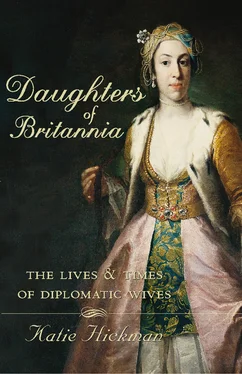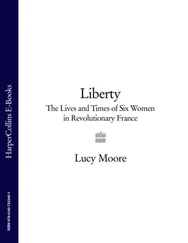In real life, of course, women were made of much sterner stuff, but nevertheless departures were often very painful. ‘The parting with my people was unexpectedly terrible,’ wrote Mary Fraser on the eve of her first diplomatic posting to China in 1874. ‘Till the moment came I had not realised what it was to mean, this going away for five years from everything that was my very own.’ Revived by a glass of champagne, thoughtfully provided by her husband Hugh, she soon pulled herself together, however, and ‘by the time the sun went down’, she would remember, ‘on a sea all crimson and gold, my thoughts were already flying forward to all the many strange and beautiful things I was so soon to see.’ 4
This poignant mixture of excitement and regret is probably superseded by only one other concern. Thirty years after Ella Sykes travelled to Chinese Turkistan, Diana Shipton was told by her husband Eric that he had been offered the post of consul-general in Kashgar. ‘Mentally,’ she wrote, ‘I began immediately to pack and to plan.’ 5
The notion of travelling light has always been an alien one to diplomatic wives. ‘We are like a company of strolling players,’ wrote Harriet Granville, only half jokingly, en route to Brussels in 1824. Over the centuries many others must have felt exactly the same. When Lady Mary Wortley Montagu, whose husband Edward was appointed ambassador to Constantinople, arrived in Turkey in 1717, the Sultan lent their entourage thirty covered wagons and five coaches in which to carry their effects. Mary Waddington, who travelled to Russia in 1883, did so with a staff of thirty-four, including a valet and two maids, a master of ceremonies, two cooks, two garçons de cuisine , three coachmen and a detective. ‘Four enormous footmen’ completed the team, Mary recorded with gentle irony, ‘and one ordinary sized one for everyday use’. 6 Even as recently as 1934, when Marie-Noele Kelly arrived by P & O in Cairo, she was accompanied by three European servants, three children, and fourteen tons of luggage. * The prize, however, must surely go to Lady Carlisle who, when her husband made his public entry into Moscow in 1663, accompanied him in her own carriage trimmed with crimson velvet, followed by no fewer than 200 sledges loaded with baggage.
When Elizabeth Blanckley’s family travelled to Algiers, where her father was to take up his post as consul, they chanced upon Nelson and his fleet in the middle of the Mediterranean. ‘Good God, it must be Mr Blanckley,’ † Nelson is reputed to have exclaimed when he saw their little boat, all decked out ‘in gala appearance’ with flags of different nations. ‘How, my dear Sir, could you in such weather trust yourself in such a nutshell?… But I will not say one word more, until you tell me what I shall send Mrs Blanckley for her supper.’
My father assured him that she was amply provided for [recalled Elizabeth Blanckley in her memoirs] and enumerated all the live stock we had on board, and among other things, a pair of English coach-horses which, to our no trifling inconvenience, he had embarked, and stowed on board. Nelson laughed heartily at the enumeration of all my father’s retinue, exclaiming, ‘A perfect Noah’s ark, my dear sir! – A perfect Noah’s ark.’ 7
Even the most determinedly rugged travellers, such as Isabel and Richard Burton, whose highly idiosyncratic approach to diplomatic life broke almost every other rule, travelled with prodigious quantities of luggage. On Isabel’s first journey to Santos in Brazil, where Richard was appointed consul, she took fifty-nine trunks with her, and a pair of iron bedsteads. It is hard to imagine anyone further from Major Leigh Hunt’s fanciful picture of the swooning and feather-brained female abroad than Isabel Burton. This was the woman who, when she learnt that she was to be Richard Burton’s wife, sought out a celebrated fencer in London and demanded that he teach her. ‘“What for?” he asked, bewildered by the sight of Isabel, her crinoline tucked up, lunging and riposting with savage concentration. “So that I can defend Richard when he is attacked,” was the reply.’ 8 Carrying out the order issued by her husband when he was finally dismissed from his posting in Damascus – the famous telegram bade her simply ‘PAY, PACK AND FOLLOW’ – was really a life’s work in itself. Although Richard was little short of god-like in Isabel’s eyes, when it came to the practicalities of their lives, she knew very well who was in control. ‘Husbands,’ she wrote, ‘… though they never see the petit détail going on … like to keep up the pleasant illusion that it is all done by magic.’ 9
One wonders who was responsible for overseeing the household of Sir William and Lady Trumbull when they travelled to Paris in 1685. The vast body of correspondence describing Sir William’s embassy gives us almost no information about his wife other than that she had ‘agreeable conversation’ and once enjoyed ‘a little pot of baked meat’ sent to her by the wife of the Archbishop of York. We do know, however, the exact contents of her luggage. The Trumbull household consisted of forty people, including Lady Trumbull and her niece Deborah.
Besides a coach, a chaise, and 20 horses, there were 2 trunks full of plate, 9 boxes full of copper and pewter vessels, 50 boxes with pictures, mirrors, beds, tapestries, linen, cloth for liveries, and kitchen utensils, 7 or 8 dozen chairs and arm chairs, 20 boxes of tea, coffee, chocolate, wine, ale and other provisions; 4 large and 3 small cabinets, 6 trunks and 6 boxes with Sir William and Lady Trumbull’s apparel, and 40 boxes, trunks, bales, valises, portmanteaux, containing belongings of Sir William’s suite. 10
Handbooks for travellers, particularly in the late nineteenth century when the empire was at its height, were often aimed at readers who were going abroad, as diplomats were, to live for some time. They enumerated at length not only what to take for a two- or three-year sojourn, but also exactly how to take it. Major Leigh Hunt, perhaps because of his military background (Madras army), was very particular on the subject.
First there were the different types of trunk available. These include a ‘State Cabin Trunk’, made from wood with an iron bottom, for hot, dry climates; a ‘Dress Basket’, made of wicker, for damp climates; and a ‘Ladies Wicker Overland Trunk’, for overland travel (it was shallow, and could easily be stowed beneath the seat in a railway carriage). Then, of course, there was the ubiquitous travelling bath. One’s china, he advised, ‘should be packed, by a regular packer, in barrels’. Sewing machines were to go in a special wooden case; saddles in a special tin-lined case; paint brushes, he warned, should have their own properly closed boxes ‘or the hairs will be nibbled by insects’. Even a lady’s kid gloves, well-aired and then wrapped in several folds of white tissue paper, should be stored in special stoppered glass bottles.
Useful items of personal apparel include ‘several full-sized silk gossamer veils to wear with your topee’ and ‘ a most liberal supply of tulle, net, lace, ruffles, frillings, white and coloured collars and cuffs, artificial flowers and ribbons’. Furthermore ‘pretty little wool wraps to throw over the head, and an opera cloak, are requisites which should not be overlooked’. Among essential household items the major lists mosquito curtains, punkahs, umbrellas and goggles; when travelling by sea, a lounge chair; drawing materials, wool and silks for ‘fancy work’; a water filter, lamps, a knife-cleaning machine; and no fewer than half a dozen pairs of lace curtains. Other recommended sundries include:
a refrigerator
a mincing machine
a coffee mill
a few squares of linoleum
Читать дальше












